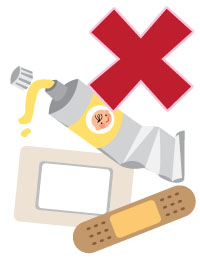Introduction

Baby care is not as simple as it looks. Taking your baby to immunisation, feeding and carrying your baby, caring their delicate skin, bathing, changing nappies… etc are all part of baby care. All first-time mums and dads need to learn about all these how-to activities. Let's look at the following helpful tips!
Safety
Carrying your baby
As the neck muscles of a newborn are not yet strong enough to support the weight of his head, please see the video below to know the proper way to carry your baby.
Ways to carry a baby – English
Narrator: Anna, when taking Ivan out of the cot, you can use one hand to support his neck and head and use the other hand to hold him like this. At other times, let his head rest on your elbow and use both hands to hold his body. And if you want to hold him upright, you can use one hand to support his head and neck, and wrap the other arm around his bottom. To put him down, use one arm to support the neck and head, and place him on the bed gently.
Baby's safe sleeping position and environment
Baby's safe sleeping position and environment
Narrator: Let babies sleep on their backs
Sleep in their own cot
Dress them in light and comfortable wear
They do not need pillows
Leave their arms uncovered
Don't place any soft and fluffy objects in the cot
Leave no gaps between the mattress and the cot
Distance between the vertical bars of the cot should be less than 6 cm
Place the baby cot next to the parents' bed
If you need to share a bed with your baby for some reason, give him a separate blanket; for a baby aged less than 3 months old, you may place him in a basket
Don't take alcohol or drugs if you are to sleep with babies.
Keep good ventilation and a comfortable temperature. There should not be any smokers in the family
Don't leave babies alone on a bed or sofa without guards
Lastly, breastfeeding can protect against SIDS (sudden infant death syndrome in subtitle), after feeding and burping the babies, put them in the cot when they look sleepy. That helps them build a good sleeping habit.
Please visit www.fhs.gov.hk
Hygiene
Trimming baby's nails
Trimming baby's nails
Narrator: Babies' nails grow rapidly. You need to trim them once to twice a week. Find a place with good lighting. The best time to trim your baby's nails is when she lies quietly especially when she is asleep. Hold your baby's fingers with your thumb and index finger and separate her fingers when you trim with a baby nail clipper or scissors. Be careful not to cut your baby's fingers. The easier way to trim baby's nails is to push down on the skin of her fingertip and trim along the curve of the nail gently. Don't trim too close to the skin. Don't leave any sharp edges on the nails to prevent babies from scratching themselves. You may shape the sharp edges with an emery board.
Cleaning baby's eyes
- It is common for newborns to have some blockage of their relatively narrow tear ducts. The blockage will cause tears collecting over the edge of the eyelids.
- Tears collected at the corners of their eyes appear as mucous discharge and may dry up.
- If the discharge increases, turns into dark yellow or green, and the eyes become bloodshot or pinkish, your baby could have eye infection. You should consult the doctor as soon as possible.
How to clean your baby's eyes – English
Narrator: Wash your hand before cleaning your baby's eyes. Use cotton balls dipped in cool boiled water. Wipe from the inner to the outer corner of your baby's eye. Use a new cotton ball for each wipe. Repeat until the eye is thoroughly clean. Repeat the same steps for the other eye. You can clean your baby's eyes once on twice daily or whenever it is necessary.
Cleaning the umbilical cord
The time for the stump of the umbilical cord to fall off varies in different babies. It usually falls off 5-10 days after birth although it can also fall off 3 weeks or even later after birth.
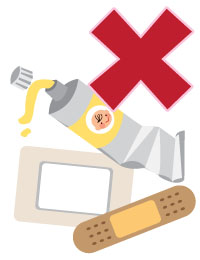
- If your baby's umbilical cord is still attached when he reaches 1 month old, you should consult a doctor.
- There may be a few drops of blood or discharge when the stump of the umbilical cord falls off.
- Clean the stump of the cord after your baby has a bath and whenever there is discharge from the base of the stump.
- Keep baby's navel and the stump dry. Do not put any medications on them or cover them up.
-
Make sure the diaper does not cover the stump. This will prevent bleeding caused by the umbilical cord rubbing against the diaper when your baby moves.


-
If the skin around the base of the cord turns red or there is foul-smelling yellowish discharge from the cord, it may be infected. You should consult the doctor as soon as possible.
Cleaning umbilical cord for newborn
Heading: Cleaning umbilical cord for newborn
Narrator: Cleaning umbilical cord for newborn
The umbilical cord stump of a baby usually falls off 5 to 10 days after birth, but the timing varies among babies. Some may take 3 weeks or even longer.
It's important to keep the cord clean and dry before it falls off. You need to clean the baby's cord when you find sticky fluid oozing from its base, which is the junction between the cord and the abdominal wall, like after bathing or changing nappies.
Super: Things for cleaning cord; Cool boiled water; Cotton buds
Cleaning a newborn's umbilical cord. To start, prepare some cool boiled water and cotton buds. Then wash your hands. Undress your baby to reveal the belly button area. Dip a cotton bud into the cool boiled water, gently clean areas around the base of the cord and then discard the cotton bud.
Use a new cotton bud soaked with cool boiled water for every wipe. Repeat the same procedure until the base of the cord is completely clean. Lastly, clean the cord stump in the same way.
After cleaning the cord, you can dress your baby. Put the nappy below the umbilical cord to avoid covering or touching it. This can help keep the cord dry and prevent bleeding caused by nappy rubbing against the cord when the baby wiggles.
It's normal to see a little blood near the belly button after the cord stump has just fallen off. Don't worry. Moreover, there could still be some discharge on the belly button. Just keep cleaning the belly button until it becomes completely dry.
In case there are signs of infection, such as skin redness around the base of the cord, foul smell or pus, or presence of a lump, take your baby to a doctor immediately.
This video is produced by the Family Health Service of the Department of Health
Show Transcript
Changing diapers and cleaning the diaper area
Before feeding your baby, always check if he needs a diaper change. Please watch the following video on the steps in cleaning the diaper area and changing diapers.
Changing nappy for baby
Heading: Changing nappy for baby
Narrator: Changing nappy for baby
Super: Things for changing nappy; Clean nappy; Cotton wool; Baby cream; Clean clothes
Narrator: Before changing your baby's nappy, make sure you have everything you need, like a clean nappy and cotton wool soaked with cool boiled water. Also prepare some baby cream and clean clothes where necessary. Remember to wash your hands before changing nappies.
Put your baby on a changing mat. Unfasten the nappy tapes. When changing nappy for a baby boy, you need to watch out as he tends to wee right after the nappy is taken off. So, unfold the nappy slowly and check before wiping.
Hold up your baby's legs using one hand to slightly lift his bottom. Fold the front part of the nappy inward to cover the soiled side. Then place the baby's bottom back onto the unsoiled front side of the nappy.
It's time to clean now. Use a piece of damp cotton wool to wipe and clean the genital area and the bottom. Use a new piece for every wipe. Pay attention to areas between skin folds, like those between the bottom and the thighs .
For a baby boy, you also need to lift the scrotum to clean the underside and areas between all the little folds.
When cleaning a baby girl, always wipe from front to back to prevent any excretion from getting into her urinary and vaginal openings located in front of her anus, which could cause infections.
Also, a baby girl's genital is delicate and can be hurt easily. So there's no need to rub and clean inside the folds.
After cleaning, roll up and reseal the soiled nappy, then set it aside before disposing of it.
Take a clean nappy and place the half with the tapes beneath your baby's bottom. Put on a new nappy when the baby's skin is dry. You may put a thin layer of barrier cream first if necessary.
Fold up the front flap, tuck it around your baby's waist and secure it by attaching the tapes to the front part of the nappy. If you change nappy for a newborn, remember to fold down the top of the nappy to prevent the nappy from covering the umbilical cord.
After putting on the nappy, check if it fits well. You should be able to comfortably run your fingers between the nappy and your baby's tummy and thighs. If it is too loose, wee and poo may leak out from the sides. If it is too tight, it will cause discomfort.
Lastly, put your baby in a safe place such as a baby cot. Remember, never leave your baby alone on the changing table or your bed!
Dispose of the soiled nappy in the garbage bin and wash your hands afterwards.
This video is produced by the Family Health Service of the Department of Health
Notes:
- You don't need to wipe the inside of the baby girl's labia as they are very tender and can be hurt easily.
- You should wipe from the front to the back when cleaning to avoid bringing any stool to the urethra and vagina and causing infection.
- For baby boys, remember to clean the scrotum and the area underneath.
- Remember to fold the diaper below the stump of the umbilical cord before it falls off. This can keep the cord dry and clean, as well as avoid bleeding caused by the cord rubbing against the diaper.
Bathing
Bathe, dry and change your baby as quickly as possible to avoid him get chilled. Before bathing your baby, you should get everything ready. The essential things for use are : water basin, bathing gel, towels, clothes, diapers, cotton balls, wet cotton wool, cotton tips and cold boiled water for cleaning the umbilical cord. All these things should be placed within your reach.
Baby bath time – English
Scene: Bathroom
Sub-heading: Add cold water before hot water
Narrator: Fill the basin with cold water then hot water when preparing for a baby bath. About 5 to 8 cm of water is enough. Remember to test the water temperature with your elbow or a thermometer. 37 to 38 degree celsius is the ideal water temperature for bathing babies.
Scene: Room with the water basin on a table.
Sub-heading: Get everything ready
Narrator: You may add a little baby soap or bathing gel if you like. Put everything needed within your reach before bathing your baby. These include the water basin, baby soap or bathing gel, clean clothes, towels, a diaper, cotton wool balls and cold boiled water. Turn on a bathroom heater in cold weather. Remove all accessories from your hands and wash them before bathing your baby. Prepare the clean clothes first by putting one layer of clothing inside another. In this way, dressing your baby can be made quicker. Undress your baby, leaving only the diaper on. Wrap him with a big towel to prevent him from wiggling around. Support your baby's body with your forearm. Use your underarm to hold his feet in place.
Scene: Bathing the baby by washing his hair first.
Narrator: Support the back of his neck and his head with your hand. Rinse his head from the front to the back in a circular motion. Be careful not to let water and soap drip into your baby's eyes and ears. Put baby on a firm surface and towel dry immediately. Take off the diaper, wipe your baby's bottom thoroughly if he has soiled. Carry the baby with your arm supporting his head and neck. Hold your baby's arm with one hand and grip his feet with your other hand. After putting your baby into the bath, release his feet. Then, you can wash the baby. Pay attention to clean the skin creases such as under his armpits, thighs and neck. Turn baby around slowly and use one hand to support his jaw and chest when rinsing his back. Avoid letting water run into his mouth and nose. Afterwards, place him on a firm surface and dry your baby especially the creases thoroughly. Put on the diaper and clothes for him immediately. You can clean baby's eyes and face at this time.
Notes for attention:
-
Keep the place for bath warm
- Bathe your baby during afternoon which is the warmer time of the day
- Turn on the heater to warm up the room before bathing in winter
-
Prepare the bathing water
- Put in cold water before adding hot water
- About 2-3 inches (about 5-8 cm ) depth of water is enough.
- Test water temperature with your elbow. The temperature should be37-38°C(98.6-100.4°F)
-
Pay attention to your baby's safety
- Remove all accessories from your hands and arms
- Remember to support your baby's head and neck
- Never leave your baby in the water basin alone, or leave to the care of other children

Oral care
From birth, parents should regularly clean their baby's mouth every day
Cleaning baby's nose
Newborns have very narrow nasal passage. They may have stuffy breathing at times. Babies sneeze frequently to help remove mucus plugs in their nasal cavity. It's best not to put anything inside your baby's nostrils (including cotton buds) as this can damage the lining of the nose.
You can clean your baby's nose when bathing him. Soak a cotton ball in some warm water and gently wipe around the nostrils to remove any mucus.
Baby's clothes
Changing clothes made simple
Clothing for your baby – English
Heading: Clothing for your baby
Sub-heading: Dress your baby quickly
Scene: Baby lying on a firm surface with mother clothing for him
Narrator: Try to change for your baby quick so that he won't get chilled. Before taking off your baby's clothes, have a set of clean clothing ready, with layers of clothes already fitting into one another. When dressing your baby, put your hand through the layered sleeve, then grasp your baby's hand and pull it through the sleeve. Roll your baby's body slightly to the side to put on the other sleeve in the same way. By doing so, you can dress your baby quickly and efficiently. Lastly, fasten the buttons or strings on your baby's clothes.
How to choose clothes for babies?
Choose the right clothes for your baby – English
Heading: Choose the right clothes for your baby
Scene: Various types of clothes for baby
Narrator: Avoid picking clothes made of nylon and wool or garment with laces, as these materials can irritate baby's delicate skin. It is better to pick cotton clothing which is soft, comfortable, water absorbent and non-irritating to skin. In cold weather, you may consider putting on a wool sweater on top of a cotton underwear to avoid baby's skin to have direct contact with wool. Collar, sleeves and pants which are tight may affect baby's blood circulation. For his comfort and easy changing, you should choose clothes with no collar, loose sleeves and made from more elastic materials. Choose clothing in simple designs for your baby. Often check whether the buttons and strings are securely attached. For clothes with zippers and buttons, they should be in the front and can be unbuttoned or unzipped to the calves. This will be more convenient for changing diapers.
How to wash baby's clothes?

Basically, baby's clothes can go into the laundry together with yours. The key points are choosing a mild detergent and rinsing thoroughly.
Baby's skin
Skincare
- Baby's skin is delicate and is susceptible to becoming dry and broken. It needs gentle care.
- Use fragrance- free bathing gel or just water for a baby's bath.
- The skin of your baby may look dry and will peel off in the first month. This is perfectly normal and you don't need to put body lotion on your baby.
- When your baby is already one month old, you may apply a mild body lotion on your baby after bath to prevent loss of moisture in dry weather.
- Avoid exposing baby under the sun directly when going out. Use an umbrella or put a bonnet on your baby to protect him from the sun. Do not apply sunscreen on your baby to avoid causing skin irritation or allergy.
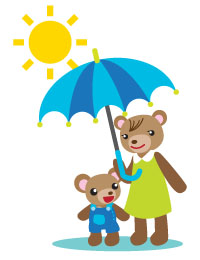
Common skin problems of babies
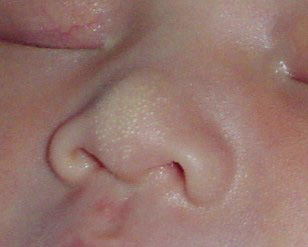
Milia
Descriptions
Cause
- Related to the premature development of the skin glands
Symptoms
- Common among newborns
- Appear as white or yellow dots of the size of a needle tip, flat on touching
Affected areas
- On forehead, cheeks, chins and nose
- Appears as white bumps on some babies' gum (Epstein's pearls)
Treatment and prevention
- Usually disappear on their own 2-3 weeks after birth. No specific treatment is needed.
- Do not squeeze or apply medications
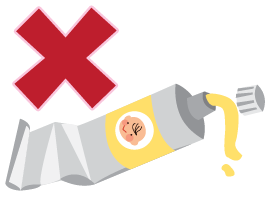
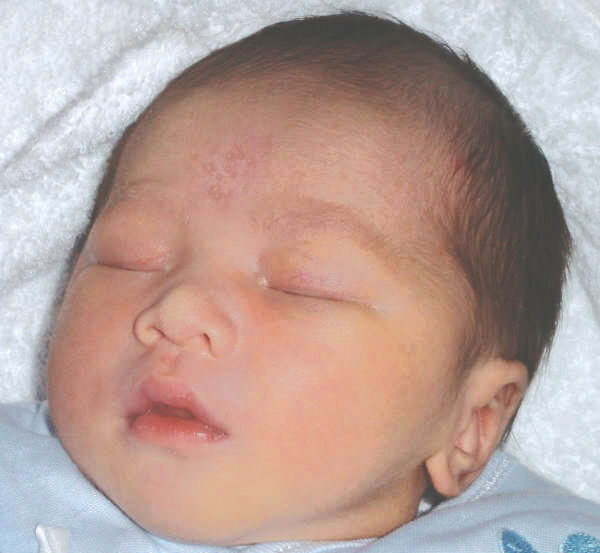
Neonatal Acnes
Descriptions
Cause
- Due to mother's hormones crossing the placenta to the baby during pregnancy
Symptoms
- Small raised reddish bumps
- Commonly found a few days or weeks after birth
Affected areas
- On foreheads and cheeks
Treatment and prevention
- Shall disappear on their own within 3 months after birth. No special treatment is needed.
- Keep skin clean and dry. Do not squeeze or apply any medications

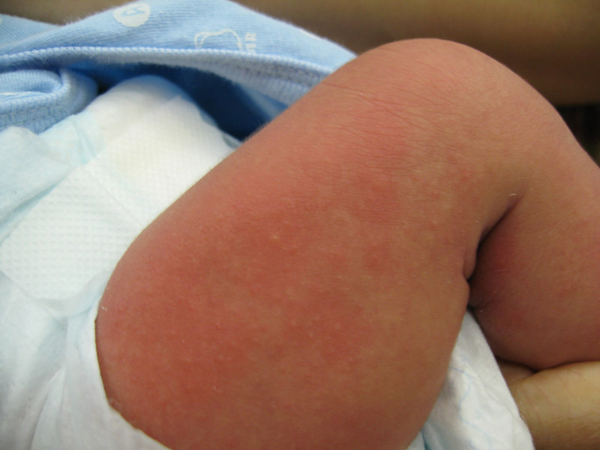
Erythema Toxicum
Descriptions
Cause
- Unknown
Symptoms
- White or yellow dots of the size of a needle tip, surrounded by blotchy redness
- Commonly appear 2-3 days after birth.
Affected areas
- Commonly found on cheeks, trunk, back, hands and feet
Treatment and prevention
- Usually disappear on their own within a few days to weeks after birth. No special treatment is needed.
- Do not squeeze or apply medications

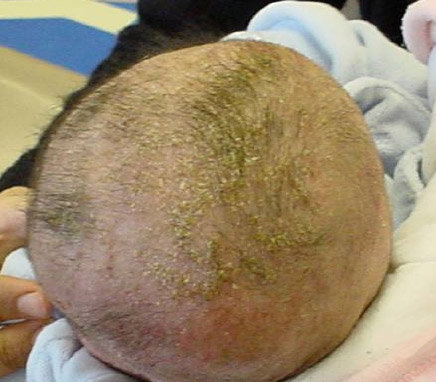
Seborrhoeic Dermatitis (Commonly known as ‘cradle cap')
Descriptions
Cause
- Not completely clear
Symptoms
- Common among newborns
- Appears slightly red
- Small oily flakes or yellowish thick scales adhering to the scalp or eyebrows, forming a layer of scab
- Commonly found when baby is 3 weeks to 3 months old
- Subsides gradually at around 6 months old
Affected areas
- Areas with lots of skin glands
- e.g. head, forehead, cheeks, eyebrows, ears, armpits, belly and the folds between the thighs
Treatment and prevention
- Keep baby's skin clean.
- Rinse the affected areas with water. Do not use soap / bath gel.
- Apply moisturizing cream after cleaning to keep the skin moist
- For thick scales on scalp, apply olive oil and leave on the scalp for 20 minutes to soften them. Wipe the scales off gently with cotton swabs.
- Rinse with baby shampoo. Use a comb to clear away the adhered patches
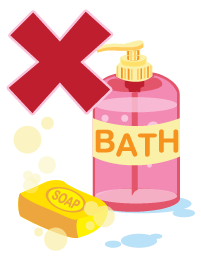
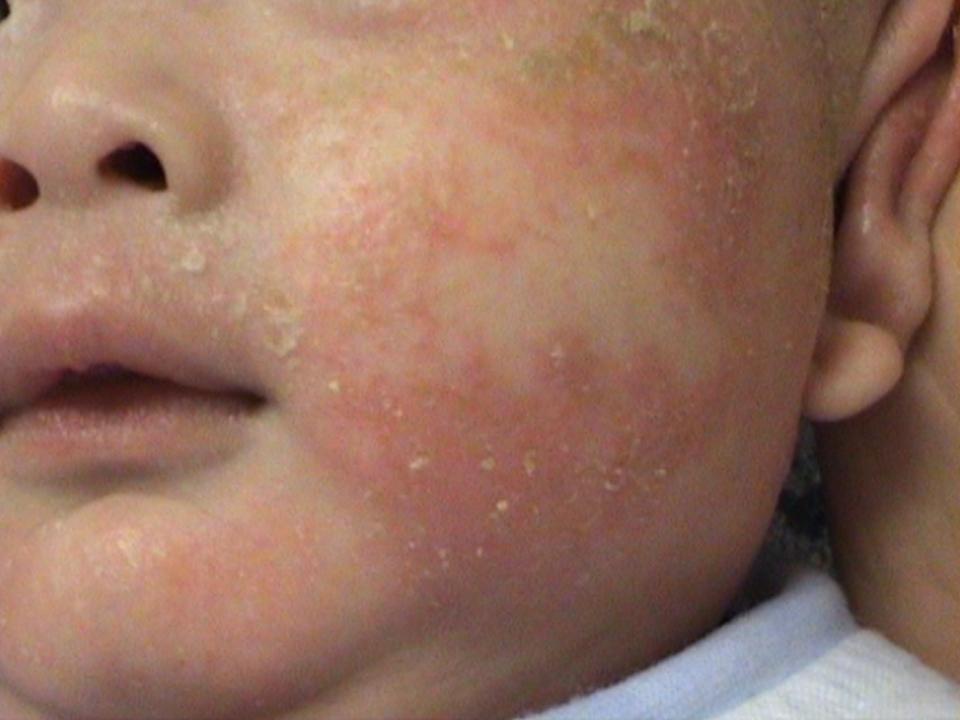
Infantile Eczema/Atopic Dermatitis
Descriptions
Cause
- Unknown
- Not infectious
- More likely to appear in babies with family members suffering from allergies (e.g. asthma, allergic rhinitis) or being allergic to certain substances (e.g. pollen, detergents, dust or foods)
Symptoms
- Commonly found in babies 2-3 months old
- Appears red and dry. Sometimes, small blisters appear and scabs are formed when blisters broken
- Baby will scratch the affected areas due to itchiness
- Skin becomes thick and hard after scratching
- In most cases, it appears before the age of 5 and fades away after 15. Some may persist into adulthood
Affected areas
- Cheeks, elbows, knees, trunk and folds between thighs.
- The affected areas will vary with age.
- Commonly found on neck and folds on limbs when reach the age of 2.
Treatment and prevention
- Keep skin clean and moist
- Bathe baby with lukewarm water and non-alkaline bathing gel
- Pay attention to cleaning the skin folds
- Apply fragrance-free moisturizer after bath
- Trim baby's nails regularly to reduce the chance of skin injury by scratching. May put cotton gloves on baby if the baby scratches a lot
-
Pay attention to the temperature and humidity of the environment. Avoid exposing directly to strong sunlight or cold wind.
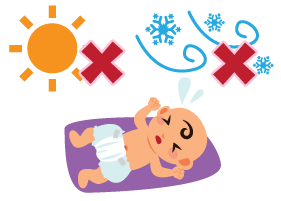
-
Clean your home with wet cloth or vacuum cleaner to remove dust
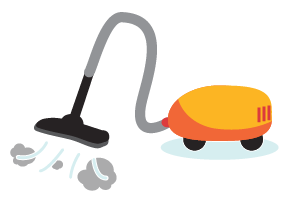
- Do not keep furry pets
-
Choose cotton clothes for your baby. Avoid clothes made of wool, nylon or silk to be in direct contact with baby's skin.
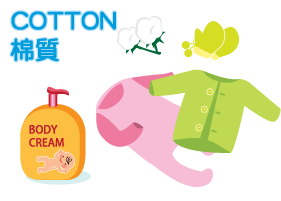
- Use mild detergent to wash baby's clothes. Rinse with water thoroughly.
- Breastfeeding may prevent eczema.
- If symptoms persist or get worse, consult your doctor before applying any medications.

Heat Rash/Prickly Heat
Descriptions
Cause
- Usually in hot weather
- Occurs when wrapped in excessive clothing
- Caused by sweat staying on skin
Symptoms
- Small raised red spots
Affected areas
- Neck, back and chest
Treatment and prevention
- Clean with a towel and water
- Dress in appropriate amount of clothing
- Keep skin dry and cool; reduce sweating
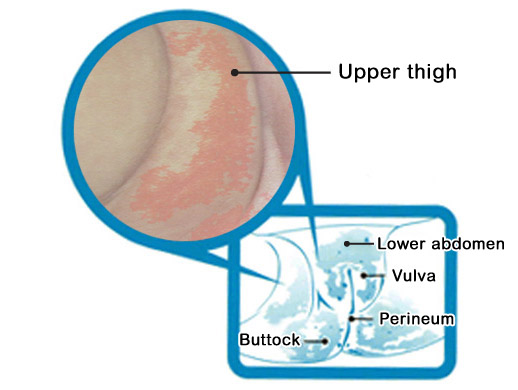
Diaper Rash/Nappy Rash
Descriptions
Cause
- When skin is irritated by urine and faeces
Symptoms
- Begins as red spot, then develops into small raised reddish rash
- Sometimes spread to all areas covered by diaper
Affected areas
- Vulva, perineum, buttocks and areas wrapped by diapers.
- Sometimes may appear on lower abdomen and upper part of the thighs.
Treatment and prevention
- Keep baby's bottom clean and dry.
- Clean with damp cotton wool when changing diapers.
- Allow the bottom to air dry. Apply a thin layer of oil-based moisturizer (Vaseline) or zinc oxide cream to keep the urine and faeces from direct contact with the skin.
- Do not use talcum powder. It will mix with urine or sweat to clog the sweat pores and worsen the condition.

*If the above symptoms persist, please consult your doctor.
Baby's health
Newborn Jaundice
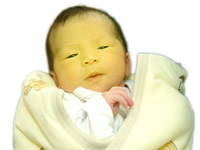
- Infants' immature liver may not be able to cope with the bilirubin produced in blood; this will lead to “neonatal jaundice”.
- Common among most newborns.
- Jaundice usually presents as yellowish discolouration on the newborn's face.
- When the bilirubin increases, the newborn's whites of the eyes, chest, belly and limbs will turn yellowish gradually.
- The phenomenon will disappear without treatment in 1-2 weeks' time. You just need to follow the medical suggestions to observe and follow up as directed.
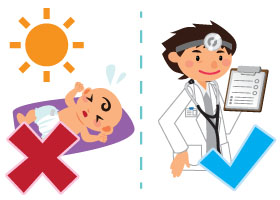
- However, if bilirubin continues to increase, it may damage the newborn's brain system.
- The baby may need to take blood tests on bilirubin if necessary. This helps to decide whether treatment of phototherapy is needed.
- Sunbathing is not an appropriate method to treat neonatal jaundice. Treatment for jaundice should be under medical supervision.
- You should continue breastfeeding if your baby is already on breast milk.
- It is important to follow the medical advice to attend regular follow ups in monitoring the baby's conditions
Indicators of possible serious illness
Young babies cannot express when they have any physical discomforts. It is important for you to pay close attention to your baby's conditions and responses so that any negative signs and symptoms can be detected quickly. You should consult the doctor as soon as possible if any following indicators of severe illness appears in your baby.
Conditions
Energy level
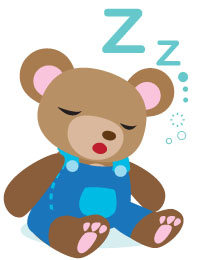
Usual patterns
- Normal newborns sleep for long hours. Nonetheless, they wake up every few hours for milk. They should look contented and energetic after feed.
Illness indicators
- Sudden changes in the usual pattern. Behaves totally different
- Looks tired and sleepy; not awake at meal times.
Breathing
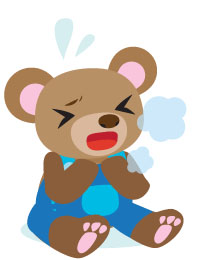
Usual patterns
- Babies normally breathe 20-40 times per minute.
- Breathing is most regular during sleep. When awake, there may be rapid breathing for a short period of time
Illness indicators
- Persistent rapid breathing, e.g. baby less than 2 months old has over 60 breaths in a minute; baby aged 2-3 months has over 50 breaths per minute.
- Effortful in breathing, or unable to suck
- Flared nostrils when breathing in.
- Have bluish or dusky discolouration on skin and lips
Blood circulation
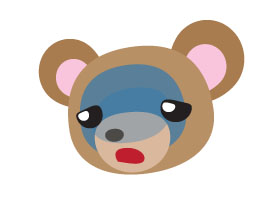
Usual patterns
- Babies' limbs will appear blue when being exposed to coldness but should turn pink as soon as they are warmed up
- Face, tongue and lips may turn blue when holding breaths momentarily while crying hard. Colours on these parts will restore once the baby is calmed down.
Illness indicators
- If baby turns pale suddenly and persistently or turns blue all over, there may be problems with baby's heart or lung.
Hydration
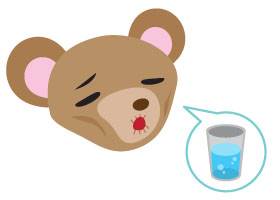
Usual patterns
- Dehydration occurs rapidly when babies vomit or have diarrhea. Make sure babies have adequate water intake at such time.
- Babies less than 1 month old gets sufficient water intake from their milk-feeds.
- The normal milk intake for infant formula-fed babies is about 10-22 ozs (300-600ml) for 6-8 feeds everyday
- Breast-fed babies normally has around 8-12 feeds according to their demand. They will look contented when they have enough. They will have at least 6 wet diapers in a day
Illness indicators
Babies (particularly newborns) can be at risk of dehydration if :
- reduced milk intake in the past 24 hours
- urine output noticeably decreases in the past 24 hours
State of the tummy
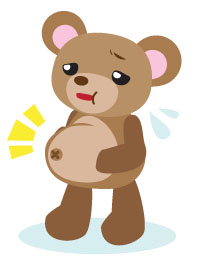
Usual patterns
- Most babies have slightly swollen tummy especially when they have a large feed.
- Their tummy should be soft between meals especially when they are asleep
Illness indicators
- If the tummy feels distended and firm persistently with constipation or passing gas for 1 day or more, or baby has repeated vomiting, it may signal some bowel problems
Body temperature
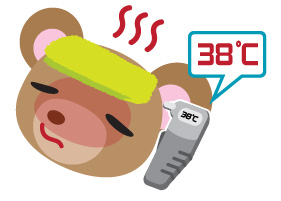
Usual patterns
Normal body temperature
- Rectal:36.6°C – 38°C (97.9°F – 100.4°F)
- Tympanic:35.8°C – 38°C (96.4°F – 100.4°F)
- Axilliary:34.7°C – 37.3°C (94.5°F – 99.1°F)
Illness indicators
- If baby is unusually cranky and warm, take him temperature immediately.
- Rectal temperature is more accurate. If the rectal temperature of baby is over 38°C / 100.4°F, baby has a fever and may have an infection
- When there is a fever, conditions can deteriorate quickly for babies in the first month or so.
*If you have queries about how much your breastfed baby suckles, you can check with the doctors and nurses. Consult the doctor immediately if any of the indicators appears in your baby.
Feeding
Breastmilk or infant formula?
Children's early nutrition and dietary patterns have tremendous impact on their future growth and health. Therefore, how you are going to feed your baby is an important decision.
Breastfeeding is the natural and superior way of feeding. Breastmilk can provide babies with all the necessary nutrients as well as natural antibodies. The composition and supply of breastmilk will self-regulate with the baby's growing needs. The intimate physical contact during breastfeeding enhances the bonding between mother and baby, thus brings satisfaction to the mother. These unique properties of breastfeeding cannot be replaced by infant formula feeding.
Some mothers are unable to breastfeed or they may prefer infant formula for some reasons. Infant formulae can provide the basic nutrients for babies. However, parents must pay attention to the proper preparation of infant formula and ways of bottle feeding.
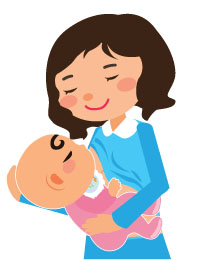
Spitting up
Babies may cry a lot or suck too rapidly in feeding. This will result in air being swallowed and gathered in the stomach. They may spit up a little milk together with the air during burping or when being laid down after feeding. Clean your baby well with a towel after spitting to decrease the chance of having rash caused by skin irritation.
Tips to reduce spitting up
- Feed baby in a calm mood and peaceful surroundings.
- Do not interrupt or distract your baby during feeding.
- Don't wait till your baby is too hungry to feed to avoid him suckling/ sucking too rapidly.
- Avoid over-feeding your baby. Feed on demand no matter you are breastfeeding or use bottle feeding.
- Make sure your baby suckles properly when breastfeeding.
- Hold your baby in your arm instead of letting him lie down when bottle-feeding.
- Hold your baby close in a semi-upright position with his head and neck resting on your elbow so he can breathe and swallow comfortably.
- Hold the bottle horizontally or slightly tipped when bottle feeding, to prevent the milk from pouring too quick. This allows your baby to control the milk flow through active sucking, and can also avoid over-feeding him.
- Burp your baby half way during feeding or when baby has finished suckling one of your breasts.
- Burp your baby until he has burped. However, babies do not burp all the time. In that case, you can continue to feed your baby after a few minutes of burping.
- Hold your baby upright for about 10-20 minutes after burping before putting him down. Don't put a pillow directly under your baby's head to avoid the risk of suffocation.
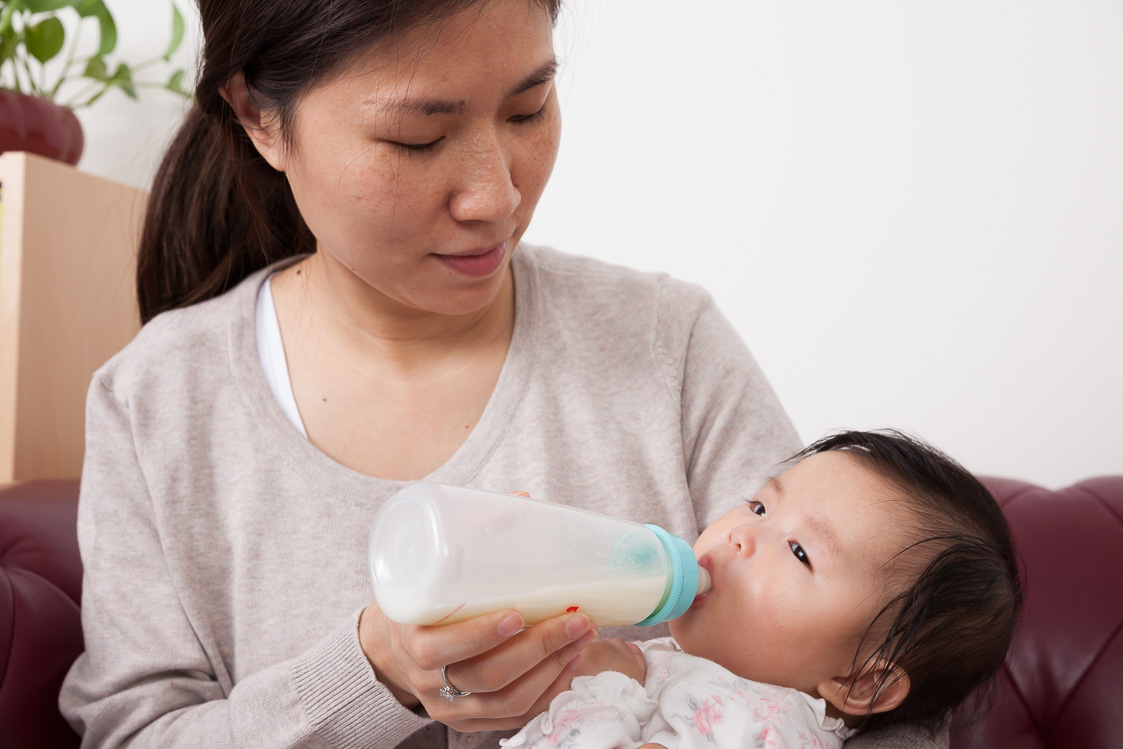

The difference between spitting up and vomiting
Spitting up:
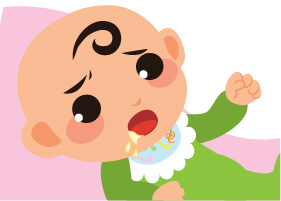
Vomiting:
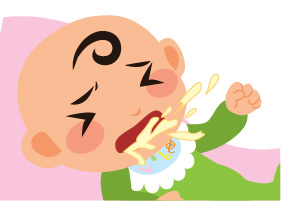
Burping
- Burp your baby after feeding or half way through feeding can reduce spitting up.
- Although breastfed babies are less likely to spit up than bottle-fed babies, they still need to be burped.
- Skills in burping video
How to burping your baby
Heading: How Should Babies be Burped?
Super: I've Got Hiccups!
Narrator: How should babies be burped?
Before burping, place a cloth on your shoulder and hold your babies upright with their chin resting on your shoulder.
Super: Rest Babies' Chin on your Shoulder
Narrator: Gently pat or rub their back for a few minutes.
Super: Gently Pat or Rub Babies' Back
Narrator: You can also sit them on your lap.
Super: Sit Babies on your Lap
Narrator: Place the palm of your hand flat against their chest and support their chin and jaw.
Super: Support Babies' Chest, Chin and Jaw
Narrator: Lean them slightly forwards
Super: Lean Babies forwards Slightly
Narrator: and gently rub or pat their back with your spare hand for a few minutes.
Super: Gently Pat or Rub Babies' Back
Narrator: To prevent food from being spat out, keep them upright for 10 to 20 minutes after burping.
Super: Family Health Service
Department of Health
www.fhs.gov.hk
June 2024
Narrator: This video is produced by the Family Health Service of the Department of Health.
Hiccups
- Hiccups are caused by sudden involuntary contractions of baby's diaphragm
- It is normal for babies to hiccup after feeding and they are not actually bothered
- Most hiccups have no obvious reasons
- Babies could have short period of hiccups when they have a full stomach after rapid sucking. Hiccups will stop without any treatment.
- If you do want to do something to reduce the hiccups, you may let your baby suckle again on your breast. You can give your baby some lukewarm water if he is bottle-fed. Burping may be another way you can do.
Poo and Pee
What baby's stools tell you
The stools of newborns will change in form depending on the milk they feed on. Below are the different conditions of stools produced by breast-fed and bottle-fed babies:
Days of Newborns after birth
Day 1-2
Dark green stools called meconium
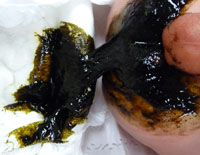
Day 3-4
Meconium gradually turns to yellowish stool
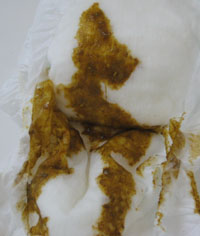
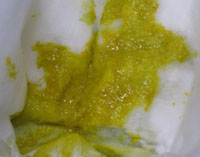
Day 5
Either yellow, green or greenish yellow in colour
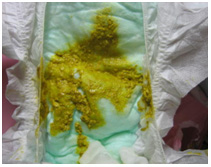
Breast-fed:
- More frequent, have at least 3 bowel movements in a day, or even after every feed
- Reduce in frequency gradually after 1 month old to every other day or every few days.
Bottle-fed:
- Less frequent
Breast-fed:
Smaller
Bottle-fed:
Larger
Breast-fed:
Loose, mushy, gradually becomes soft and grainy

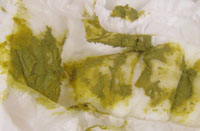
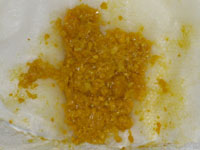
Bottle-fed:
Texture like clay

Telling Diarrhea or constipation from the baby's stools
Diarrhea:
More than 6-8 times per day or more frequent than usual
Constipation:
Less regular (e.g. from once a day to once every 3 days, or from every 3 days to once a week)
Diarrhea:
Watery stools, sometimes there may be mucus or blood
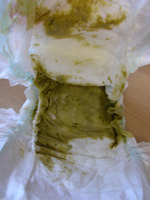
Constipation:
- Hard and dry, like marbles
- Has difficulties in passing stool, can be effortful or even painful
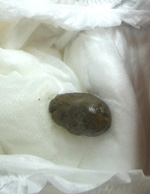
Diarrhea:
Consult the doctor immediately if the above conditions occur

Constipation:
- May be caused by insufficient water or fibre in the baby's food intake. You can check whether the proportion of infant formula to water in preparing milk is correct; or whether your baby is sweating a lot.
- Consult the doctor immediately if the condition persists
Babies vary in their bowel habit. As long as the stool is soft in texture, it is normal even if your baby passes stools every 2 to 3 days.
Baby's sleep
Baby's safe sleeping position and environment
Baby's safe sleeping position and environment
Narrator: Let babies sleep on their backs
Sleep in their own cot
Dress them in light and comfortable wear
They do not need pillows
Leave their arms uncovered
Don't place any soft and fluffy objects in the cot
Leave no gaps between the mattress and the cot
Distance between the vertical bars of the cot should be less than 6 cm
Place the baby cot next to the parents' bed
If you need to share a bed with your baby for some reason, give him a separate blanket; for a baby aged less than 3 months old, you may place him in a basket
Don't take alcohol or drugs if you are to sleep with babies.
Keep good ventilation and a comfortable temperature. There should not be any smokers in the family
Don't leave babies alone on a bed or sofa without guards
Lastly, breastfeeding can protect against SIDS (sudden infant death syndrome in subtitle), after feeding and burping the babies, put them in the cot when they look sleepy. That helps them build a good sleeping habit.
Please visit www.fhs.gov.hk
Creating a safe sleep environment
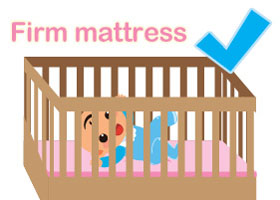

Ensuring the safety of your baby's sleep environment is of paramount importance. An unsafe sleep environment can be fatal to your baby.
Here is a checklist of a safe sleep environment for babies. How many of these are you doing?
-
Sleeping with your baby in the same room in separate beds

-
The distance between the bars of the crib should be less than 6cm (2.5″)
-
Remember to pull up and lock the rail of the crib when you leave your baby alone in crib
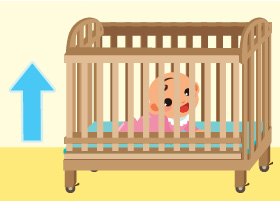
-
The size of the mattress should be fitted in the crib to prevent baby from rolling into the gap
-
Make sure baby's face and head are exposed above the blanket to prevent smothering and overheating
-
Let your baby wear light and comfortable clothing at bedtime
-
Keep the room well-ventilated with comfortable temperature for your baby
The following 4 situations may threaten your baby's sleep safety. ‘Watch out' and ‘Don't'
-
Mattress too soft and thick will make baby easily roll over to a face- down position which may lead to suffocation.
-
Use baby pillow or let baby sleep on big, soft and fluffy beddings or other objects. These include light, soft blankets or duvets, sheep skin, bean bag chair, bumper, pillows or stuffed toys. Your baby could be smothered easily when the objects cover the baby.
-
Place things other than beddings (e.g. toys and clothing) in baby's bed.
-
Too much clothing or too many blankets can make the baby too hot.
Although the mobility of newborns is limited, accidents can happen at home beyond your expectation. Bear in mind that:
“Baby's safe sleeping position and environment, You are the one to care”
Vaccination
Although your baby may have some discomfort when taking vaccination, it can protect your baby's health. As newborns are vulnerable to infections, to protect your baby against diseases and strengthen his immunity, you should bring him at allotted time to receive the appropriate vaccines and boosters. Immunisation can be given by injection or by mouth. When the vaccines are injected into the body, antibodies will be produced to give immunity against diseases.
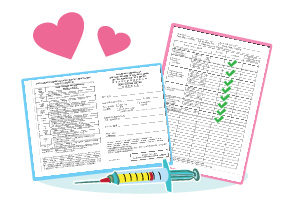
You can bring your newborn to 5 year old child to the Maternal and Child Health Centres of Department of Health(DH), private hospitals or clinics for immunisation. The School Immunisation team of DH will visit primary schools to provide injection to students. You can also bring your child to private doctors for vaccination.
Vaccinations that newborn babies receive in hospitals
| Age | Immunisation recommended | No. of dose | Method of Immunisation |
|---|---|---|---|
| Newborn | BCG vaccine | Injection | |
| Hepatitis B vaccine | 1st dose | Injection |
| Age | Newborn | |
|---|---|---|
| Immunisation recommended | BCG vaccine | Hepatitis B vaccine |
| No. of dose | 1st dose | |
| Method of Immunisation | Injection | |
Care after BCG vaccination
- The BCG vaccine prevents tuberculosis. Some babies may have small red papules, ulcer or pus at the site of injection within 2 to 4 weeks after the vaccination. These reactions will subside and heal naturally within a short period of time, leaving a scar or even no scars at all. Occasionally a few children may develop lumps under the armpit due to enlarged glands. Other adverse reactions are extremely rare.
- You don't have to worry if the site of injection on your baby has the above described reactions. You can bathe your baby as usual. If needed, you can clean the site with cool boiled water and dry with a piece of gauze to keep it clean and dry. Besides, avoid putting on tight clothing for your baby.
- Never apply any medicated powder, ointment or solution on the vaccination site. Also, do not put plaster or bandage on the site.
